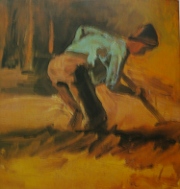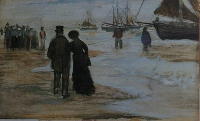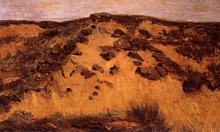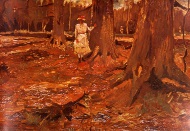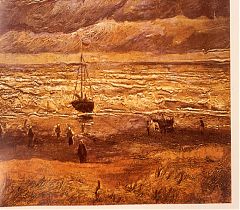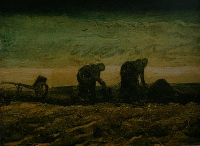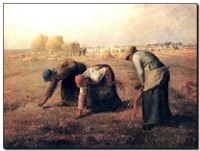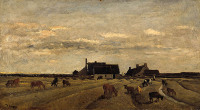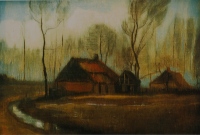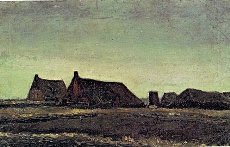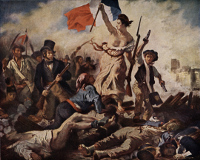The Hague and Drenthe 1881 – 1883 · 3615 dagen geleden by Ad van den Ende
A period of intense study and work1881
NOVEMBER -DECEMBER
Vincent called on his cousin-in-law, Anton Mauve (1838–1888), who was a Dutch realist painter and a leading member of the Hague School.
The Hague, 1/3 Dec. 1881.
“My dear Theo,
As you see, I’m writing to you from The Hague. I’ve been here since last Sunday. As you know, Mauve had planned to come and stay in Etten for a few days. I was afraid nothing would come of it or that it would be all too short and thought, I’ll go and try it another way, and if possible deal with it somewhat more drastically. I spoke to Mauve and said, would you approve if I were to come and trouble you for a good month or so – then when that time is up I’ll be past the first petty vexations of painting and will go back to Het Heike.
Well, Mauve immediately installed me in front of a still life consisting of a couple of old clogs and other objects, and so I could set to work.
And I also go to him in the evenings to draw.”
That Christmas Vincent refused to go to church, quarreling violently with his father. As a result he left home the same day for The Hague.
1882
JANUARI
In January 1882 Vincent settled in The Hague. Mauve lent him money to set up a studio.
Vinent meets Sien Hoornik, an alcoholic prostitute. For a while they live together. Sien occasionnally sits for him.
Vincent’s relations with Mauve cool off. His relations with other painters are strained as well. The only one who really values his work is Jan Hendrik Weissenbruch.
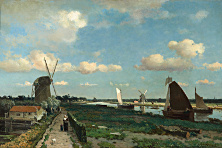
Weissenbruch, a member of the Hague School
MAY
To Theo van Gogh. The Hague, on or about Sunday, 7 May 1882.
“My dear Theo,
Today I met Mauve and had a very regrettable conversation with him which made it clear to me that Mauve and I have parted ways for ever. Mauve has gone so far that he can’t retract it, or at least certainly wouldn’t want to. I asked him to come and see my work and talk things over afterwards. Mauve refused outright, ‘I certainly won’t come to see you, it’s over and done with’.
(…)
Mauve blames me for saying, I’m an artist – which I won’t take back, because those words naturally imply always seeking without ever fully finding. It’s the exact opposite of saying, ‘I know it already, I’ve already found it’. To the best of my knowledge, those words mean ‘I seek, I pursue, my heart is in it’.
(…)
And yet – and yet – and yet. I wish that Mauve regretted it. People suspect me of something… it’s in the air… I must be hiding something… Vincent is keeping something back that may not be divulged.. Well, gentlemen, I’ll tell you – you who set great store by manners and culture, and rightly so, provided it’s the real thing – what is more cultured, more sensitive, more manly: to forsake a woman or to take on a forsaken one?
This winter I met a pregnant woman, abandoned by the man whose child she was carrying.
A pregnant woman who roamed the streets in winter – who had to earn her bread, you can imagine how.
I took that woman as a model and worked with her the whole winter. I couldn’t give her a model’s full daily wage, but all the same, I paid her rent and have until now been able, thank God, to preserve her and her child from hunger and cold by sharing my own bread with her. When I met this woman, she caught my eye because she looked ill. I made her take baths and as much fortifying remedies as I could afford, she’s become much healthier.”
SUMMER
Vincent discovers tuhe attraction of oils. At first he mainly paints landscapes.
To Theo van Gogh. The Hague, Thursday, 10 and Friday, 11 August 1882.
“My dear Theo,
In the days since you left I’ve done some experimenting with painting. And thought you might be curious to know how I’m getting on. I do wish that you could be back in the studio for just an hour — that would be the best way to tell you how it turned out. Since that is, of course, impossible, I just want to say that I have 3 painted studies. One of a row of pollard willows in the meadow (behind the Geestbrug),1 then a study of the cinder road close to my neighbourhood — and today I was again in the vegetable gardens in Laan van Meerdervoort, where I found a potato field with a ditch. A man in a blue smock and a woman were gathering up the potatoes, and I put their figures in. The field was white, sandy soil — half dug over, half still covered by rows of dried stalks — with green weeds in between. In the distance dark green and a few roofs. I took the greatest pleasure in doing the last study in particular. I must say that painting is not as alien to me as you might think. On the contrary, I find it very appealing on account of it being a powerful means of expression.
And at the same time one can say delicate things with it too — let a soft grey or green speak in the midst of roughness.
I’m very glad that I have the necessary equipment, because in the past I often had to restrain myself. It opens up a much broader horizon.
Now I would like quietly to amass a good number of painted studies to hang in my studio without referring to this as a change. And should anyone express surprise at seeing painted work by me, to say: Well, did you think I had no feeling for that or couldn’t do it? But I’ve put a lot of work into drawing and will continue to do so, because it’s the backbone of painting, the skeleton supporting everything else.
I’m enjoying it so much, Theo, that I’ll have to restrain rather than push myself because of the cost. These studies are of medium size, though slightly larger than the lid of an ordinary painting box, because I don’t work in the lid, but instead pin the painting paper for the study to a frame with canvas stretched across it, which is easy to carry.
Before I paint bigger things, I’ll draw them bigger. Or, if I can find out the technique — I’ll look into it — make what they call grisailles of them. It becomes too expensive a business if you’re not sparing with the paint.
But, old chap, it’s wonderful for me that I’ve once again been given so many good tools — thanks again for everything. I’ll do my best to ensure that you need have no regrets, but rather the satisfaction of seeing the progress made.
I’m writing now just for the time being to say that I’ve made a start. It goes without saying that the studies must become more beautiful — and that certainly they have their shortcomings too — but I believe that even in these first ones you’ll already see that there’s something of the open air in them, something that proves I have a feeling for nature and the heart of a painter. Herewith a small sketch of Laan van Meerdervoort. The vegetable gardens there have a sort of Old Dutch cachet that always appeals to me.
Well, good-night, it’s late, with a handshake.
Ever yours,
Vincent
I’m busy with Zola’s ‘La curée’.
When I’d written this letter, I realized that it lacked something. I thought — I must ensure that I can write to him that I’ve tackled a piece of sand, sea and sky like we saw together at Scheveningen. Then I kept my letter back and marched off to the beach this morning, and have just got back with a fairly large painted study of sand, sea and sky, and a few fishing-boats and men on the beach.7 There’s still dune sand in it, and I assure you this won’t be the last one. I thought you’d be pleased that I’ve tackled this.”
To Theo van Gogh. The Hague, Monday, 14 August 1882.
“You must excuse me for writing again — it’s to tell you that I take so much pleasure in painting. (…)
I just wanted to tell you — I feel that things with colour are becoming apparent in my painting that I didn’t use to have, things to do with breadth and strengths. I shan’t send you anything immediately — let it first ripen a little — but you should know that I’m full of enthusiasm, and believe that it’s going well at the moment. (Before 3 months have passed, however, I’ll send you something to keep you informed and give you an idea.)
But for me that’s precisely a reason to push on — and to learn what I still need.
So don’t take what I say about my own work as meaning that I’m already content with it — the opposite is true, but I believe that this much has been gained, that if something in nature strikes me I now have more means at my disposal with which to express it more forcefully.
And I don’t find it disagreeable that from now on what I make will look more appealing.
I also don’t think that it would be a hindrance if my health let me down on occasion. As far as I can make out, it isn’t the worst painter who can’t work for a week or a fortnight now and then. Sometimes the reason for this is that they’re the very ones who ‘put their heart and soul into it’, as Millet says. That doesn’t matter, and in my view one shouldn’t spare oneself when it comes to the point. One may be exhausted for a while, but one recovers, and the advantage is that one has gathered in one’s studies, just like the farmer does his corn or hay.
Now for my part I’m not yet thinking about ‘having a rest’. But yesterday, Sunday, I didn’t do much, at least I didn’t go out of doors. I want to make sure that even if you come as early as this winter you’ll find the studio full of painted studies.
I received a letter from Rappard yesterday. He has been to Drenthe, and judging by two sketches he sent me he hasn’t been idle. He seems to be working very hard, and well too, both on figures and landscape.
Well, adieu, I must go out, with a handshake.
Ever yours,
Vincent
It’s now almost exactly two years ago that I began drawing in the Borinage.”
To Theo van Gogh. The Hague, Sunday, 20 August 1882.
“Sunday afternoon.
My dear Theo,
I’ve just received a good letter from home which truly gives me great pleasure, and from which it’s clear that your visit and the things you said about me and my work have left an impression that reassures them.
I believe this can only have desirable consequences, and I thank you in particular for the way in which you talked about me, though it seems to me you’ve praised me more about one thing and another than I yet deserve. At home they seem to be very pleased with their new surroundings, and are still full of your visit.
As I am myself, by the way, for various things you said to me cause me to think of you even more than I used to, certainly not with less affection. What you told me about your health, in particular, makes me think of you often.
I am well — I feel fine not avoiding anything because of it, and just carrying on. But, as you’ll understand, it isn’t entirely over. At times, mainly in the evening when I’m tired, it troubles me, but fortunately it’s no longer such that it stops me working.
This week I painted a few fairly large studies in the woods which I’ve tried to work up more highly and elaborate more than the first ones. The one I believe I’ve been most successful with is no more than a stretch of soil dug over — white, black and brown sand after a downpour. So that the clods of earth catch the light here and there and are more expressive. After I’d been sitting in front of that piece of soil for a while drawing, there came a thunderstorm with torrential rain that lasted a good hour. I had become so fascinated, however, that I stayed at my post and sheltered as best I could behind a big tree. When it had finally passed and the crows took to the air again, I wasn’t sorry I had waited, because of the wonderfully deep tone the ground of the wood had taken on after the rain.
Because I had started before the storm on my knees with a low horizon, I now had to kneel down in the mud, and it’s because of similar adventures, which happen very often in different ways, that it seems sensible to me to wear ordinary working clothes that aren’t easily ruined.
The outcome this time was that I was able to take that piece of soil with me to the studio — although Mauve rightly said to me when we were discussing one of his studies that it’s a job to draw clods of earth and to get depth into them.
The other study from the woods is of big green beech trunks on a ground with dead leaves, and the small figure of a girl in white.
The great difficulty there was to keep it clear and bring in space between the tree-trunks, which stand at different distances — and the place and relative thickness of the trunks altered by the perspective. To ensure, in short, that one can breathe and wander about in it — and smell the woods.
I particularly enjoyed doing these two. (…)
One of the things I like about painting is that for the same effort as for a drawing one takes home something that conveys the impression much better and is much more pleasing to look at. And at the same time more accurate.
In a word, it’s more rewarding than drawing. But it’s absolutely essential that one draw the objects in the correct proportion and position with some certainty before one begins.
If an error is made there, it will all come to nothing.(…)
I’m sorry that now it may be a year before you see what I’m painting all together — even if I send something now and again — and before we can discuss what to do and how. I believe I can assure you that my painting these things now will prove to be worthwhile. Perhaps what failed in January will now succeed.
Do not, above all, suspect me of indifference as regards earning; I fully intend to take the shortest route to that end.
Provided they are genuine and lasting earnings, of which I only see a prospect in my case if something truly good comes into my work, and not through working solely on saleability — which one pays for later — but through honest study of nature.
If you could see from the paintings that they’d have the best chance of success, I wouldn’t, of course, refuse to paint more. But should it take a long time before it becomes saleable, I would be the first to say, in that case we must live as thriftily as possible in the meantime, and with drawing one avoids a lot of costs and very certainly makes sure and steady, if slow, progress. I see a change in these painted things, and I write to you about it because you’re better placed than I am to say how this might affect possible sales. It seems to me that at any rate the painted studies are more agreeable to look at than what I’ve drawn.
For my part, I attach less importance to the more agreeable, less gaunt effect, and make the expression of more austere and manly things the aim I want to achieve, for which I must first labour hard. But if you were to say: work on those views of woods or landscapes or seascapes, then that needn’t get in the way of larger and more serious things, and I would have nothing against that.
It’s just that I would have to know that they were worth the brushes, the paint, the canvas, and that making a lot of them wasn’t a waste of money, but that the costs could be recouped. If that was or could become the case, it might be a way of enabling me to undertake more difficult things.
In that case I would even work on them with great ambition. I want to begin by letting them ripen somewhat, by working them up a bit more highly. Then in a few months, say, I’ll send you something and we can see. I believe that most painters have worked their way up to higher things in this way. I wouldn’t want to make things that were bad in principle, tending towards the untrue and the false, because nature is too dear to me. But we’re faced with this question: I must make many more studies in order to achieve something higher and better. What will work out cheaper: drawing or painting those studies? If the paintings are unsaleable, it will certainly be cheaper to draw in charcoal or something else.
The reason why I myself am delighted with painting is not the agreeable appearance, but the fact that it throws light on other questions of tone and form and material before which I used to be helpless, but now I can attack them with this means. I do now see, for example, more opportunity to have another try with charcoal and get a result.
But supposing it was possible to recover the cost of painted studies, I want to say to you that in principle I would have nothing against that, now I see that I’m making some headway and that it could perhaps be an exceptional opportunity.
My only objection in principle is to expending paint on things that can also be learnt with something else, while there’s still no question of selling. I don’t want to put either you or me to great expense for no good purpose, but I see clearly that the painted things have a more agreeable appearance. This makes me unsure as to what to do.”
Paris and its surroundings may be beautiful, but we can’t complain here either. This week I painted something which I believe may give some idea of the impression of Scheveningen as we saw it when we walked there together. A large study of sand, sea, sky — a big sky of delicate grey and warm white through which an occasional spot of soft blue shines — the sand and the sea light — so that the whole becomes blond, though enlivened by the bold and distinctively coloured figures and pinks, which take on tone. The subject of the sketch I made of it is a pink weighing anchor. The horses stand ready to be hitched to the pink before pulling it into the sea. I enclose a scratch of it. I really laboured over it — I wish I’d painted it on panel or canvas. I tried to get more colour into it, namely depth, firmness of colour. (…)
Yesterday evening I was occupied with an area of woodland with a slight upward slope covered in rotting and dead beech leaves. The ground was lighter and darker red-brown, all the more so because of the cast shadows of trees that threw bands across, weaker or stronger, half blotted out. The problem, and I found it to be most difficult, was to get the depth of colour — the enormous strength and fixity of that area — and yet it was only while painting that I noticed how much light there still was in that darkness. To keep it light and yet keep the glow, the depth of that rich colour, for there’s no carpet imaginable as splendid as that deep brown-red in the glow of an autumnal evening sun, although tempered by the wood. (…)
’m describing nature to you — to what extent I conveyed it in my sketch I’m not sure myself — but I do know that I was struck by the harmony of green, red, black, yellow, blue, brown, grey. It was very Degroux-like, an effect similar, for example, to that sketch of the conscript’s departure formerly in the Palais Ducal.
Painting it was hard graft. There are one and a half large tubes of white in the ground — yet that ground is very dark — in addition red, yellow, brown ochre, black, terra sienna, bistre, and the result is a red-brown that varies from bistre to deep wine-red and to pale, blond reddish. Then there are also mosses and an edge of fresh grass that catches the light and sparkles brightly and is very difficult to get. There at last you have a sketch which — whatever may be said about it — I maintain has some meaning, says something.
While making it I said to myself: let me not leave before there’s something of an autumn evening in it, something mysterious, something with seriousness in it.
However, because this effect doesn’t last, I had to paint quickly. The figures were done with a few vigorous strokes with a firm brush — in one go. I was struck by how firmly the slender trunks stood in the ground — I began them using a brush, but because of the ground, which was already impasted, one brushstroke simply disappeared. Then I squeezed roots and trunks into it from the tube, and modelled them a little with the brush. Yes, now they stand in it — shoot up out of it — stand firmly rooted in it. In a sense I’m glad that I’ve never learned how to paint. Probably then I would have learned to ignore effects like this. Now I say, no, that’s exactly what I want — if it’s not possible then it’s not possible — I want to try it even though I don’t know how it’s supposed to be done. I don’t know myself how I paint. I sit with a white board before the spot that strikes me — I look at what’s before my eyes — I say to myself, this white board must become something — I come back, dissatisfied — I put it aside, and after I’ve rested a little, feeling a kind of fear, I take a look at it — then I’m still dissatisfied — because I have that marvellous nature too much in mind for me to be satisfied — but still, I see in my work an echo of what struck me, I see that nature has told me something, has spoken to me and that I’ve written it down in shorthand. In my shorthand there may be words that are indecipherable — errors or gaps — yet something remains of what the wood or the beach or the figure said — and it isn’t a tame or conventional language which doesn’t stem from nature itself but from a studied manner or a system.(…)
As you see, I’m immersing myself in painting with all my strength — I’m immersing myself in colour — I’ve held back from that until now, and don’t regret it. If I hadn’t drawn I would never have felt or tackled a figure that looks like an unfinished terracotta. But now, I feel I’m on the high seas — painting must proceed with all the strength that we can muster.
If I work on panel or canvas, the cost go up again — everything is so expensive — paint is expensive too, and is used up so quickly. Well, these are drawbacks that all painters face — we must see what’s possible. I know for sure that I have a feeling for colour that will develop more and more, that painting is in my very marrow. I appreciate it enormously that you support me so loyally and strongly. I think of you so often — I would so much like my work to be substantial, serious, manly, and for it to give you pleasure as soon as possible.”
AUTUMN
To Theo van Gogh. The Hague, Sunday, 22 October 1882.
“I can agree entirely with what you say about times one occasionally has when one seems to be deadened to the things of nature, or when nature no longer seems to speak to us.
I, too, often have that, and sometimes it helps if I turn to something very different. If I’m dead to landscape or effects of light, I tackle figures, and vice versa. Sometimes there’s nothing to be done except wait for it to pass, but on many occasions I manage to get rid of the unresponsiveness by changing the subjects I’m concentrating on. I’m becoming more and more fascinated by figures though. I remember having had a time in the past when the feeling for landscape was very strong within me, and I was much more struck by a painting or drawing in which a light effect or the mood of a landscape was well expressed than by figures. In general, the figure painters even inspired in me a kind of fairly cool respect rather than warm sympathy. However, I well remember being particularly struck at the time by a drawing by Daumier, an old man under the chestnut trees in the Champs Elysées (an illustration for Balzac), although the drawing wasn’t that important. But I remember that it struck me so forcefully that there was something so firm and manly in Daumier’s approach that I thought: it must be good to feel and think like that and overlook or ignore a mass of things so as to concentrate on something that’s thought-provoking and appeals to a human being as a human being more directly than meadows or clouds.”
To Theo van Gogh. The Hague, Sunday, 26 and Monday, 27 November 1882.
“Perhaps the most wonderful passage in Uncle Tom’s cabin is the one where the poor slave, sitting by his fire for the last time and knowing that he must die, remembers the words
Let cares like a wild deluge come,
And storms of sorrow fall,
May I but safely reach my home,
My god, my Heaven, my All.
This is far from all theology — simply the fact that the poorest woodcutter, heath farmer or miner can have moments of emotion and mood that give him a sense of an eternal home that he is close to.
Just as I get back from the printer’s I receive your letter. I think your Montmartre is splendid, and I would certainly have shared the emotion that it evoked in you. I believe, by the way, that Jules Dupré or Daubigny also often tried to arouse those thoughts in their work. Sometimes there’s something indescribable in those effects — it’s as if the whole of nature is speaking — and when one goes home one has the same feeling as when one has just finished a book by Victor Hugo Hugo, for example. For my part I can’t understand that not everyone sees and feels it — after all, nature or God does it for everyone who has eyes and ears and a heart to perceive. I think that a painter is happy because he’s in harmony with nature as soon as he can depict, to some extent, what he sees.
And that’s a great deal. One knows what one has to do; there’s an abundance of subjects and Carlyle rightly says, Blessed is he who has found his work. If that work — as in the case of Millet, Dupré, Israëls &c. — is something intended to bring peace, to say sursum corda or ‘lift up your hearts’, then it’s doubly encouraging.
One is also less alone then, because one thinks: I may be here on my own, but while I’m here holding my tongue my work may be speaking to my friend, and whoever sees it won’t suspect me of being cold-hearted. Understand, however, that the dissatisfaction about poor work, the failure of things, the technical difficulties can make one terribly melancholy.
I assure you that when I, for my part, think of Millet, of Israëls, Breton, Degroux — so many others, Herkomer among them — I can be terribly despondent. One only knows what those fellows are when one is at work. Now, to stomach that despondency and melancholy as one is, to be patient with oneself, not to take a rest but to toil despite a thousand shortcomings and faults and the precariousness of the victory — that’s why a painter is also not happy: the battle with himself, improving himself, renewing his energy. All this complicated by the material difficulties.”
1883
SEPTEMBER
To Theo van Gogh. The Hague, on or about Wednesday, 5 September 1883.
“My dear Theo,
I received your letter just now when I came home from the dunes behind Loosduinen, soaking wet because I had spent 3 hours in the rain at a spot where everything was Ruisdael, Daubigny, or Jules Dupré.
I came back with a study of crooked, windswept trees, and a second of a farm after the rain. Everything is already bronze, everything is what one can see in nature only at this time of year, or if one stands before one of those paintings like a Dupré, for instance, and so beautiful that one’s imagination always falls short of it.
You write about your walk to Ville-d’Avray that Sunday, at the same time on that same day I was also walking alone, and I want to tell you something about that walk, since then our thoughts probably crossed again in some degree.
I spoke to the woman as I wrote to you — we felt that staying together in the future was ruled out, indeed that we’d make each other unhappy, but we felt on both sides how strongly we were attached to each other. And then I went out of doors, a long way away, to talk to nature for a while.
Well, I came to Voorburg, and went from there to Leidschendam.
You know the landscape there, superb trees full of majesty and serenity beside green, dreadful, toy-box summer-houses, and every absurdity the lumbering imagination of Hollanders with private incomes can come up with in the way of flower-beds, arbours, verandas. Most of the houses very ugly, but some old and elegant. Well, at that moment, high above the meadows as endless as the desert, came one driven mass of cloud after the other, and the wind first struck the row of country houses with their trees on the opposite side of the waterway, where the black cinder road runs. Those trees, they were superb, there was a drama in each figure I’m tempted to say, but I mean in each tree.
Then, the whole was almost finer than those windblown trees seen on their own, because the moment was such that even those absurd summer houses took on a singular character, rain-soaked and dishevelled.
(…)
I don’t know how it will appear in years to come, or whether that wouldn’t have been better than separating; now we’re too close to everything to see things in their true context and the consequences. I hope that it will all turn out for the best, but her future and my own look sombre to me. I do believe that something will still awaken in her, but that’s precisely the point — it ought to have been awakened already, and now it will be difficult for her to follow her better thoughts when she has no one to support her in that. Now she wouldn’t listen, then she will yearn to speak to me and it won’t be possible. As long as she was with me, she had no contrasting example, and now in other surroundings she’ll remember things that she didn’t care about and paid no attention to at the time. Now, because of the contrast, she’ll think about that sometimes. For me it’s sometimes thoroughly distressing that we both feel the impossibility of struggling through the future together, and yet that we’re so attached. She has been more confiding than normal of late, and the mother had incited her to play some tricks which she didn’t want to inflict on me. Things of the kind we talked about when you were here, such as starting a row and the like.
You see, there’s something in her like the beginning of something more solid, and may that remain so. I wish she could marry, and when I tell you that I’ll keep an eye on her it’s because I advised her to do that. If only she can find a man who is half good, that’s enough, then the beginnings of what has come into her here will develop further, that is, a more domestic, simple disposition, and if she sticks to that I won’t have to leave her entirely to her fate in the future either, for then at least I’ll remain her friend, and sincerely so.
Write to me again soon, and regards.
Ever yours,
Vincent”
AUTUMN
Vincent leaves Sien and goes to Drenthe in the northern Netherlands. He goes on long walks. The dark peaty landscape makes a strong impression on him.
Vincent continues to be a voracious reader. His reading includes periodicals such as The Graphic and Harper’s Weekly.
To Theo van Gogh. Nieuw-Amsterdam, Drenthe, on or about Wednesday, 3 October 1883.
Nieuw-Amsterdam
“Before I left Hoogeveen I painted a few more studies there, among them a large farmhouse with a mossy roof. (…)
But at times — like those moments when you think about going to America – I think about going to the East as a volunteer. But they’re those wretched, sombre moments when things overwhelm one, and I would wish that you might see the silent heath that I see through the window here, because such a thing soothes one and inspires more faith, resignation, calm work.
I drew several studies in the barge, but I’m staying here to paint. I’m close to Zweeloo here, where Liebermann, among others, has been, and besides there’s an area here where there are large, very old sod huts where there isn’t even a partition between the barn and the living room. My plan for these first days is to visit that region.
But what tranquillity, what breadth, what calm there is in nature here…”
Vincent asked his brother Theo to become a painter too, and to come to Drenthe.
To Theo van Gogh. Nieuw-Amsterdam, on or about Monday, 5 November 1883.
“My dear Theo,
What I think is the best life, oh without even the slightest shadow of a doubt, is a life made up of long years of being in touch with nature out of doors — and with the something on high — unfathomable, ‘awfully Unnameable’, because one can’t find a name for it — above that nature. Be a peasant — be, if that were fitting at the present time, a village clergyman or schoolmaster — be, and given the present time that’s the form that seems to me to be the most fitting, be a Painter — and in so doing as a person you will, after that spell of years of outdoor life and manual work, as a person you will, in the end and in the passage of years, gradually become something better and deeper. I firmly believe this.
In my view, the way one starts out, cleverer, not so clever, with more or with fewer privileges of favourable circumstances, is far from being the most important thing. If one starts on it one must only do it with the belief in the need to be in touch with nature, with the belief that if one takes that path one can’t go wrong, and walks straightest.”
But Theo was wise enough to refuse it.
DECEMBER
Vincent cannot stand loneliness and moves to Nuenen in the southern Netherlands, where his parents now are living. There he stays until november 1885. Vincent reads Zola and the aesthetic writings by the French painters Delacroix and Eugene Fromentin.




